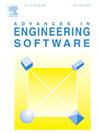Bilinear-inverse-mapper: Analytical solution and algorithm for inverse mapping of bilinear interpolation of quadrilaterals
IF 4
2区 工程技术
Q2 COMPUTER SCIENCE, INTERDISCIPLINARY APPLICATIONS
引用次数: 0
Abstract
The challenge of finding parametric coordinates of bilinear interpolation of a point with respect to a quadrilateral in 2D or 3D frequently arises as a subproblem in various applications, e.g. finite element methods, computational geometry, and computer graphics. The accuracy and efficiency of inverse mapping in such cases are critical, as the accumulation of errors can significantly affect the quality of the overall solution to the broader problem. This mapping is nonlinear and typically solved with Newton’s iterative method, which is not only prone to convergence issues but also incurs high computational cost. This paper presents an analytical solution to this inverse mapping, along with a comprehensive geometric analysis covering all possible quadrilateral configurations. It describes the invertibility of all points and extends the discussion to 3D and concave quadrilaterals. The proposed algorithm is robust, free from failure due to convergence issues or oscillations in iterative methods, and achieves approximately higher computational speed compared to Newton’s method for quadrilaterals with non-parallel opposite edges. This enables an efficient calculation of shape functions or interpolation functions at all invertible spatial points. The high-accuracy, high-speed computational solution will be particularly advantageous in applications involving high spatial or temporal discretisation (i.e. fine mesh and small timesteps) where iterative methods will be computationally expensive. The analytical solution based algorithm is available as an open-source library at https://github.com/sahu-indrajeet/Bilinear-Inverse-Mapper.
双线性逆映射:四边形双线性插值逆映射的解析解和算法
在二维或三维四边形中寻找点的双线性插值参数坐标的挑战经常作为子问题出现在各种应用中,例如有限元方法,计算几何和计算机图形学。在这种情况下,逆映射的准确性和效率是至关重要的,因为误差的积累会显著影响更广泛问题的整体解决方案的质量。这种映射是非线性的,通常采用牛顿迭代法求解,不仅容易出现收敛问题,而且计算成本高。本文给出了这种逆映射的解析解,并给出了涵盖所有可能的四边形构型的全面几何分析。它描述了所有点的可逆性,并将讨论扩展到三维和凹四边形。该算法具有鲁棒性,不会因迭代方法的收敛性问题或振荡而失效,并且对于非平行对边四边形的计算速度比牛顿方法提高了约2.4倍。这使得在所有可逆空间点上有效地计算形状函数或插值函数成为可能。高精度、高速计算解决方案在涉及高空间或时间离散化(即精细网格和小时间步长)的应用中将特别有利,其中迭代方法的计算成本很高。基于解析解的算法可以在https://github.com/sahu-indrajeet/Bilinear-Inverse-Mapper上作为开源库获得。
本文章由计算机程序翻译,如有差异,请以英文原文为准。
求助全文
约1分钟内获得全文
求助全文
来源期刊

Advances in Engineering Software
工程技术-计算机:跨学科应用
CiteScore
7.70
自引率
4.20%
发文量
169
审稿时长
37 days
期刊介绍:
The objective of this journal is to communicate recent and projected advances in computer-based engineering techniques. The fields covered include mechanical, aerospace, civil and environmental engineering, with an emphasis on research and development leading to practical problem-solving.
The scope of the journal includes:
• Innovative computational strategies and numerical algorithms for large-scale engineering problems
• Analysis and simulation techniques and systems
• Model and mesh generation
• Control of the accuracy, stability and efficiency of computational process
• Exploitation of new computing environments (eg distributed hetergeneous and collaborative computing)
• Advanced visualization techniques, virtual environments and prototyping
• Applications of AI, knowledge-based systems, computational intelligence, including fuzzy logic, neural networks and evolutionary computations
• Application of object-oriented technology to engineering problems
• Intelligent human computer interfaces
• Design automation, multidisciplinary design and optimization
• CAD, CAE and integrated process and product development systems
• Quality and reliability.
 求助内容:
求助内容: 应助结果提醒方式:
应助结果提醒方式:


